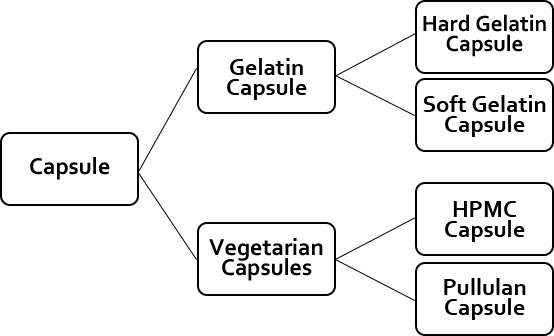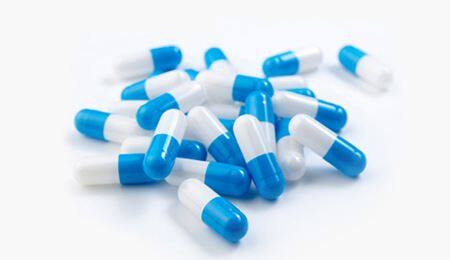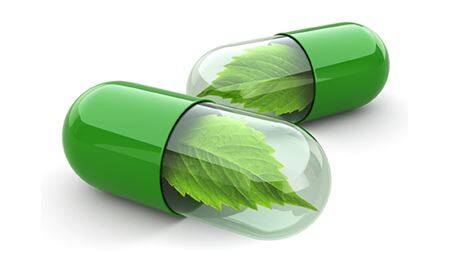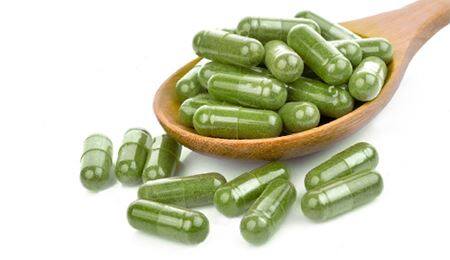This is a capsule shell guide designed to provide comprehensive information and comparison of capsules of different types, so that you can pick up the capsule type you need. Whether you are a large pharmaceutical factory or a homemade medication DIYer, or even if you just want to make some medication for your pets, you will find your capsule here.
There are generally two forms of finished products of medications: capsules and tablets. Some medication can be presented in both two forms, while some can only be presented in either one form. There are many arguments regarding choosing capsules or tablets. You may find out our point of view from the article “Tablet vs Capsule : difference in marketing, cost, absorption, etc.” This article will only discuss the differences of kinds of capsules.
Please notice that capsules are not applicable to filling with the following material or special process is required:
- The aqueous solution and the dilute alcohol solution can soften and dissolve capsules
- High soluble medication or small doses of stimulating medication: after the dissolution of the capsules shell, the stomach will be stimulated by the uneven concentration of medication.
- Medications to be easily weathered can soften capsule shells, and deliquescent medication can embrittle the capsule shells.
- Medication with strong acidity can cause hydrolysis of the capsule shell, and medication with strong basicity can cause the degeneration of the capsule shell, which will affect the disintegration of the capsule shell.
- Types of capsules shell
- Comparison of capsules of different types
- Capsule Size
- Capsule color
- How to find out capsules with high quality
Types of capsules shell
In REVISION OF MONOGRAPH ON CAPSULES, WHO defines capsules as:
Capsules are solid dosage forms with hard or soft shells. They are of various shapes and sizes, and contain a single dose of one or more active ingredients. They are intended for oral administration.
The capsule can be divided into solid drugs and liquid drugs based on the physical state (phase) of the medication to be filled. According to the raw material, the capsule can also be divided into Hard Gelatin Capsule, Soft Gelatin Capsule, HPMC Capsule, Pullulan Capsule, Starch Capsule, Enteric Capsules, Metallic Capsules etc. Here is a diagram which may help you understand the sorting well:

What Is Hard Gelatin Capsule

Hard gelatin capsule is a kind of capsule mainly composed of gelatin (9000-70-8) and purified water. Some colored hard gelatin capsules also contain a small amount of Titanium dioxide (13463-67-7) and colorants. The following table is for the composition.
| Name | Gelatin | Water | Titanium dioxide | Colorant |
| Transprent | 85% | 15% | / | / |
| Opaque | 83-84% | 15% | 0.5-1.8% | 0.2-0.5% |
The main component of gelatin hard capsules, which is gelatin, is a protein product which is harmless, inexpensive, edible, and degradable, and it is easy to store and use. It is an ideal material. Titanium dioxide acts as an opacifier, and colorant makes capsules colorful. They are all approved additives for food and medications and are recorded in JECFA. Moreover, and there is no limit for acceptable daily intake of gelatin and Titanium dioxide, and a very small amount of amino acids in the gelatin can be neglected. In fact, gelatin has been used on a large scale for more than 100 years, no obvious harm has been found when gelatin is used for pets such as cats and dogs. You could find detailed data on the properties of gelatin in the Refer we list at the end of this article.
Because of these features, gelatin has been dominant in the 100-year history of capsule production. In 2007, the total sales volume of the empty capsule exceeded 310 billion worldwide, of which gelatin capsules accounts for 94%.
If you do not have other special needs, hard gelatin capsules will be your safest choice. Compared to capsules of other types, gelatin capsules have many different suppliers because of the vast market, which will offer you more options
What Is Soft Gelatin Capsule

The composition of soft gelatin capsules is similar to that of hard gelatin capsules, except that the different moisture proportion. Usually, plasticizers will be added to keep capsules’ elasticity and stability, including Glycerol (56-81-5), Sorbitol (50-70-4) etc. It is a one-piece capsule that is processed directly from specialized equipment so it can be filled with liquid. Most features of soft gelatin capsules are similar to that of hard gelatin capsules. If you do not want to purchase the equipment for producing, many OEMs also offer processing service.
What Is HPMC Capsule

HPMC Capsule is mainly composed of HPMC and purified water. HPMC is short for HYDROXYPROPYLMETHYL CELLULOSE (9004-65-3), a kind of cellulose obtained by the hydrolysis of plants and is made by etherification. At present, it has been worldwide used in food and pharmacy industry, and recorded in the world's authoritative pharmacopeia. According to the JECFA database, there no limit for acceptable daily intake of HPMC, and GRAS (No. GRN 000213) record it as a safe material. Detailed data on the properties of HPMC can be found in the Refer we list at the end of this article.
Because HPMC is derived from plants, it is a vegetarian capsule that can be certified and help open the vegetarian markets.
What Is Pullulan Capsule

The main component of Pullulan Capsule is Pullulan and purified water. Pullulan (9057-02-7) is a water-soluble mucopolysaccharide, a mature food additive, also included in JECFA. It has become the ideal raw material for capsule production due to its good film forming properties and other excellent features, replacing animal gelatin to make pure natural vegetarian empty capsules. It is naturally fermented by Tapioca, and can be Pullulan vegetarian certificated and organic certificated, which can meet the customers’ highest demand.
In addition, with extremely low moisture content and good toughness. Pullulan capsules can be filled with water-sensitive medication. For the detailed data on the properties of Pullulan, you could find it in the Refer we list at the end of this article.
What Is Enteric Coated Capsules
To be exact, Enteric Coated Capsules do not belong to a certain type of capsules. They are made by applying an enteric coating to other common capsules or other processing. The main features of enteric-coated capsules are related to the raw materials capsules used. Enteric Coated Capsules are mainly made to meet the needs of releasing medication in the intestine. Because some medication may have strong stimulation to the stomach, and for some medication, the medicinal may be destroyed by the stomach acid, or maybe the medicinal of some medication will be better in the intestines.
Its general principle works like that, with the coating process, the enteric capsule only can be dissolved by the alkaline liquid in the intestinal tract.
Materials for enteric coatings include fatty acids, waxes, shellac, plastics, and plant fibers etc. In fact, some of these materials are not completely safe, such as some material containing phthalates. Owing to legal regulations and consumer’s growing demand on health, however, the use of these material has been reduced. If you are strict with this, please check the coated material of Enteric Coated Capsules.
Comparison of capsules of different types
Gelatin Capsules vs Vegetarian Capsules
HPMC Capsule vs Pullulan Capsule
Capsule Size
It would be better to choose the capsules size that suits your medication dosage. You can find more detailed information in the Empty Pill Capsule Size Chart.
Capsule color

An appropriate product color may help in the application and sale of your pharmacy. For example, children may prefer to eat capsules with bright colors. While some people prefer to capsules with visible medication inside, for this situation, you could choose Clear Capsule. It's also a good idea to apply the theme color for the packaging of your products, which can make your products stand out, and improve the compliance of the medication usage promote your brand. Most suppliers at scale, including CapsulCN, offers capsule customization service, and the capsule color should be chosen depending on your sales target and the medication your sales.
In addition, if you purchase capsules through the Internet, because of the display or other reasons, there may a slight color difference between the physical objects and the pictures on the network, it is better to double check to ensure you choose the color you need.
How to find out capsules with high quality
National regulations
The capsule quality plays a very important role to medications, and there are definite regulations for capsule quality in various countries and regions. You could mainly refer to USP (US Pharmacopoeia), EP (European Pharmacopoeia), JP (Japanese Pharmacopoeia) and IP (International Pharmacopoeia).
You can check the capsules, the surface should be smooth, are not hardened or softened. There should be no spots, discoloration, and the mass should be even. You can also do a disintegration experiment on capsules and have checked if they meet all the requirements.
Types of gelatin used in capsules
For gelatin capsules, the types of gelatin used in capsules is essential. Gelatin is derived from bones, skins and meats of various animals. There are many slight differences among them. The main standard for judging quality are gel strength and viscosity. The table below shows the lowest standard of our qualified gelatin, for your reference:
| Items | Unit | Specifications |
| Gel Strength 6.67%, 10℃ | g | 220-239 |
| Viscosity 6.67%, 60℃ | mPas | 4.4-5.2 |
| Visco-down 6.67% 37℃ | % | <=5 |
| Molsture | % | <=13 |
| Ashes | % | <=1 |
| pH 1.0%, 35℃ | 5.3-5.9 | |
| pH Isoionlc Point | 4.7-5.2 | |
| Insoluble Particles | % | <=0.1 |
| Physical Characteristics | Light yellow or yellow, translucent, slightly shiny particles or flakes; odorless and tasteless. | |
| Transmission 450nm | % | >=80 |
| Transmission 620nm | % | >=93 |
| Sulfur dioxide (SO2) | % | <=0.01 |
| Sulfur dioxide (SO2) | mg/kg | <=40 |
| Oxidizing Substance (is H2O2) | No blue | |
| E-Coli | 1g | Not Detected |
| Pseudomonas aeruginosa | 10g | Not Detected |
| Staphylococcus aureus | 1g | Not Detected |
| Salmonella | 10g | Not Detected |
| Total Bacteria Count | CFU/g | <=100 |
| Yeast and Mould | CFU/g | <=100 |
| Chromium (Cr) | mg/kg | <=2 |
| Conductivity 1%, 30℃ | mS/cm | <=0.5 |
| Arsenic (As) | mg/kg | <=0.8 |
| Heavy Metal | mg/kg | <=30 |
Refer:
THE JAPANESE PHARMACOPOEIA SEVENTEENTH EDITION
EUROPEAN PHARMACOPOEIA 8.0
U.S. Pharmacopeia Official Monographs USP39-NF34
Pharmacopoeia of the People's Republic of China 2010
Evaluations of the Joint FAO/WHO Expert Committee on Food Additives (JECFA): Gelatin / HPMC / Pullulan
Combined Compendium of Food Additive Specifications: Gelatin / HPMC / Pullulan
Note: This article is only the author's point of view on capsules and tablets. It would be slightly different from the facts because of some differences such as equipment differences and cultural differences.


